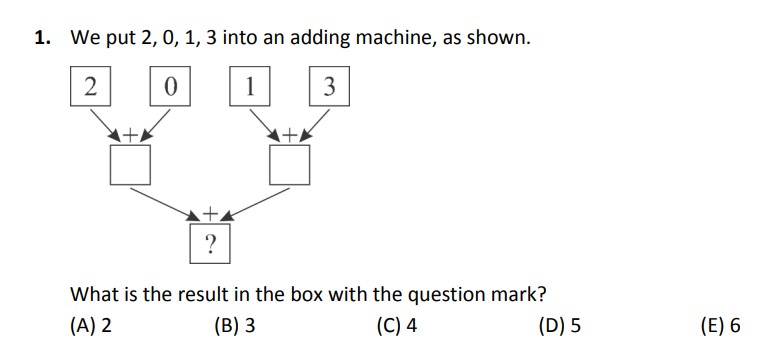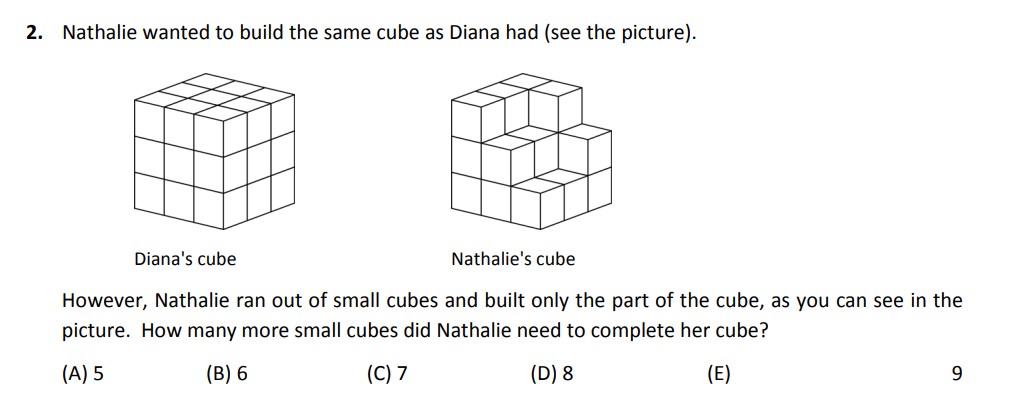
The diagram represents an “adding machine” where numbers are added at each stage in a sequence.
In the first step, we add the top two numbers, which are 2 and 0. The result is 2 + 0 = 2.
Next, we move to the bottom two numbers, which are 1 and 3. Adding these together gives 1 + 3 = 4.
Finally, we add the two results from the previous steps. We take the sum from step 1 (2) and the sum from step 2 (4). Adding these gives 2 + 4 = 6.
Thus, the final result is 6.

Diana’s cube is a 3x3x3 cube, which contains 27 smaller cubes in total, as calculated by 3 × 3 × 3 = 27.
From the image, we can see that Nathalie’s cube uses 20 smaller cubes. To determine how many cubes Nathalie still needs, we subtract the number of cubes she already has from the total number of cubes in the 3x3x3 cube:
27 − 20 = 7.
So, Nathalie needs 7 more cubes to complete her cube.

The diagram shows that ⅛ of the total distance is equal to 100 meters. To find the total distance, we need to multiply 100 by 8, since 8 × 1/8 = 1, which represents the whole distance.
Therefore, the total real distance between Mara’s and Bunica’s houses is:
100 × 8 = 800 meters.

Nick starts at point A, facing upward (north), and needs to reach point B, following the restriction of only turning right. To navigate the training ground efficiently, he must plan a route with the smallest number of right turns.
Nick first moves straight north and makes his first right turn to head east. He continues straight and then makes a second right turn to head south. Moving forward, he takes a third right turn to go west. Finally, he makes a fourth right turn to head north, reaching point B.
By following this route, Nick completes the journey with exactly four right turns, which is the minimum number required. This ensures he reaches his destination without breaking the rules or taking unnecessary detours.
Answer: (B) 4.

Ann, Bob, and Chris currently have a combined age of 31 years. In three years, each of them will age by 3 years, resulting in a total increase of:
3 × 3 = 9 years (since there are three people).
Adding this increase to their current total age gives:
31 + 9 = 40 years.
So, in three years, their combined age will be 40 years.

The Gurukan family consists of three daughters, and each daughter has two brothers. Since all the daughters share the same two brothers, there are no extra siblings to count. Additionally, the family includes two parents who are shared by all the children.
Adding up all the members:
3 daughters,
2 brothers,
2 parents.
This gives a total of 3+2+2=7 family members. The key detail is that the two brothers are shared among the daughters, so they are not counted multiple times.
Answer: (B) 7.

Michael takes a pill every 15 minutes. He took the first pill at 11:05.
Now, let’s count the next pills:
Second pill: 11:05 + 15 minutes = 11:20
Third pill: 11:20 + 15 minutes = 11:35
Fourth pill: 11:35 + 15 minutes = 11:50
Answer: (B) 11:50

When you draw two circles, they overlap and create three regions (as shown in the picture).
Now, we have to check how many regions can be formed with two squares.
Let’s break it down:
One square alone → Just 1 region (inside the square).
Two squares that don’t touch → Just 2 regions (each square is its own region).
Two squares that slightly overlap → We get more regions!
Two squares that fully cross each other (like a plus sign “+”) → The two squares divide each other into multiple sections.
When drawn in the best way, two squares can create a total of 9 regions.
So, the correct answer is (E) 9.

A number has this property if it is divisible by its last digit.
Let’s check numbers between 20 and 30:
20 → Last digit is 0 (but you can’t divide by 0, so no ❌)
21 → Last digit is 1 (21 ÷ 1 = 21, works! ✅)
22 → Last digit is 2 (22 ÷ 2 = 11, works! ✅)
23 → Last digit is 3 (23 ÷ 3 = not a whole number, no ❌)
24 → Last digit is 4 (24 ÷ 4 = 6, works! ✅)
25 → Last digit is 5 (25 ÷ 5 = 5, works! ✅)
26 → Last digit is 6 (26 ÷ 6 = not a whole number, no ❌)
27 → Last digit is 7 (27 ÷ 7 = not a whole number, no ❌)
28 → Last digit is 8 (28 ÷ 8 = not a whole number, no ❌)
29 → Last digit is 9 (29 ÷ 9 = not a whole number, no ❌)
30 → Last digit is 0 (can’t divide by 0, so no ❌)
The numbers that work are: 21, 22, 24, and 25.
That’s 4 numbers.
So, the correct answer is (C) 4. ✅

Step 1: Solve the Original Equation
The given equation is:
1+3+6×2 = 22
We need to follow the order of operations (PEMDAS):
Multiplication first: 6×2=12
Addition next: 1+3+12=16
Since 16 ≠ 22, the equation is incorrect.
Step 2: Fixing the Equation by Increasing One Number by 1
We need to increase one of the numbers in the equation by 1 to make the result 22. Let’s test each option:
Increase 1 to 2: 2+3+6×2= 17(Still incorrect!)
Increase 3 to 4: 1+4+6×2= 17(Still incorrect!)
Increase 6 to 7: 1+3+7×2= 18(Still incorrect!)
Increase 2 to 3: 1+3+6×3= 22(Correct! ✅)
Step 3: Final Answer
The correct number to increase is 2 → 3.
So, the answer is:
(D) 2 ✅

We have a 4×4 grid where dots are placed at the intersections. The goal is to choose one of the five pieces and position it in the grid in a way that covers the highest number of dots.
Each piece consists of lines connecting dots, forming different shapes. Some are more spread out, while others are more compact. The trick is to see how many dots each piece can touch when placed on the grid.
Testing Each Piece
Now, let’s analyze each piece and count the maximum number of dots it can cover when placed in the best possible way:
(A) – Covers 4 dots
(B) – Covers 4 dots
(C) – Covers 5 dots
(D) – Covers 4 dots
(E) – Covers 3 dots
Clearly, Piece (C) is the winner! It covers 5 dots, which is the highest number among all options.
Why is (C) the Best Choice?
Piece (C) has a longer and more spread-out shape, allowing it to reach one extra dot compared to the others. While (A), (B), and (D) all max out at 4 dots, (C) manages to stretch a little further and cover 5 dots. Piece (E), on the other hand, is too compact and only covers 3 dots.
Final Answer: (C) ✅

Step-by-step:
– Start: 3:00
– End: 6:15
Total time = 3 hours and 15 minutes = 195 minutes
Now, we want one-third of that time:
195 ÷ 3 = 65 minutes
So, starting at 3:00, and adding 65 minutes brings us to:
3:00 → 60 minutes = 4:00
4:00 + 5 minutes = 4:05
At 4:05, the minute hand is pointing at the 1 (each number = 5 minutes).
So we want the picture where the minute hand is at 1.
✅ Correct Answer: D

Let’s try to turn this into a math sentence.
Let’s say he caught x fish.
3 times as many = 3x
So: 3x = x + 12
Subtract x from both sides:
3x – x = 12
2x = 12
x = 6
✅ Matthew caught 6 fish
✅ Correct Answer: B

There are:
16 small 1×1 squares
6 medium 2×2 squares
4 big 3×3 squares
1 full 4×4 square
16 + 6 + 4 + 1 = 27 squares
✅ Answer: A

Max eats 18 scoops in 30 minutes
In that same time:
– Max eats 6
– David eats 4
– Peter eats 5
We need to find how many all three eat in 30 minutes
Here’s the trick: If Max eats 18 in 30 mins, that means:
When Max eats 6, David eats 4 → So if Max eats 18, David eats:
6 × 3 = 18 for Max, so 4 × 3 = 12 for David
When Max eats 6, Peter eats 5 → So 6 × 3 = 18 for Max, 5 × 3 = 15 for Peter
Now add:
Max: 18
David: 12
Peter: 15
Total = 45 scoops
✅ Correct Answer: D

Recent Comments